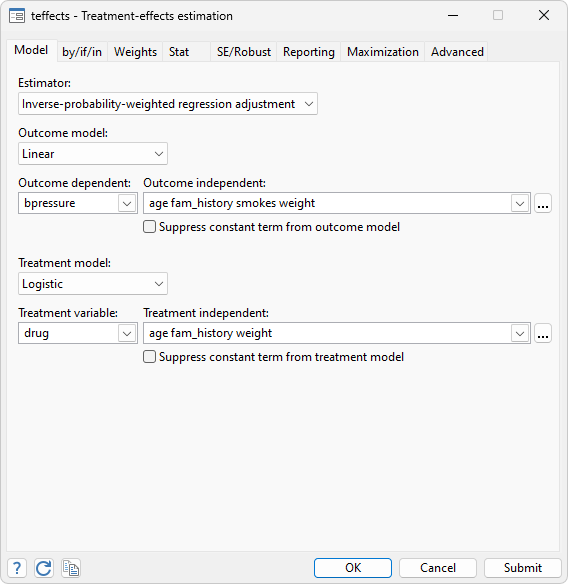ESTIMATORS
- Inverse-probability weights (IPW)
- Propensity-score matching
- Covariate matching
- Regression adjustment
- Weighted regression
- Doubly robust methods
- Augmented IPW (AIPW)
- IPW with regression adjustment
- AIPW using lasso
- Difference in differences (DID)
- Heterogeneous DID for cross-sectional data
- Heterogeneous DID for panel-data
- Difference-in-difference-in-differences (DDD)
- Panel data
Video – Treatment-effects estimation using lasso
Video – Regression adjustment (RA)
Video – Inverse-probability weighting
Video – Inverse-probability weights (IPW) with RA
Video – Augmented IPW
Video – Nearest-neighbor matching
Video – Propensity-score matching
Video – Heterogeneous difference in differences
ENDOGENEITY, HECKMAN-STYLE SELECTION, AND PANEL DATA WITH CAUSAL EFFECTS
- Linear regression
- Interval regression, including tobit
- Probit regression
- Ordered probit regression
- Exogenous or endogenous regressors
- Endogenous or exogenous treatment; binary or ordinal treatment
- Random-effects models for panel data
LEARN ABOUT EXTENDED REGRESSION MODELS
STATISTICS
- Average treatment effects (ATEs)
- ATEs on the treated (ATETs)
- Potential-outcome means (POMs)
OUTCOMES
- Continuous—linear
- Binary—logistic, probit, heteroskedastic probit
- Count—Poisson
- Fractional
- Nonnegative, including exponential mean
- Survival—exponential, Weibull, gamma, lognormal
TREATMENTS
- Binary—logistic, probit, heteroskedastic probit
- Multivalued-multinomial logistic
DIAGNOSTICS
- Overlap plots
- Covariate balance
POSTESTIMATION SELECTOR
- View and run all postestimation features for your command
- Automatically updated as estimation commands are run
CAUSAL MEDIATION ANALYSIS
- Continuous, binary, and count outcomes
- Continuous, binary, and count mediators
- Binary, multivalued, and continuous treatments
- Linear, logit, probit, Poisson, and exponential mean models
- Direct effects, indirect effects, total effects, and POMs
ENDOGENOUS TREATMENT EFFECTS
- Continuous outcome
- Count outcome
- Control-function estimator
- ATEs, ATETs, and POMs
- Test for endogeneity
DIFFERENCE-IN-DIFFERENCES (DID) AND TRIPLE-DIFFERENCES (DDD) ESTIMATION
- DID and DDD estimators for repeated cross-sections data
- DID and DDD estimators for panel data
- DID diagnostics and tests
- Test and graphs for parallel trends
- Granger causality test
- Time-specific treatment effects
- ATET inference with small number of treatment and
control groups
- Bacon decomposition
- Wild bootstrap
- Donald–Lang estimator
- Bias-corrected cluster–robust SEs
- Bell–McCaffrey degrees of freedom
HETEROGENEOUS DID
- Four estimators
- regression adjustment (RA)
- inverse probability weighting (IPW)
- augmented inverse probability weighting (AIPW)
- two-way fixed-effects regression (TWFE)
- Estimation of heterogeneous treatment effects
- Panel data
- Repeated cross-sectional data
- Graphical representation of treatment effects
- Estimate and visualize aggregations of ATETs within
- cohort
- time
- exposure to treatment
- Simultaneous confidence intervals
TREATMENT EFFECTS WITH HIGH-DIMENSIONAL CONTROLS
- Continuous, binary, and count outcomes
- Logit or probit treatment model
- ATEs, ATETs, and POMs
- Lasso or square-root lasso variable selection
- Neyman orthogonal and doubly robust estimator
- Double machine learning
- Flexible model specification


